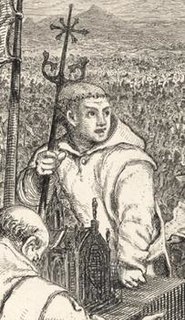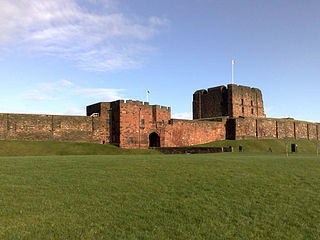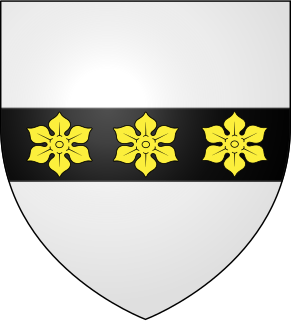| |||||
| Centuries: | |||||
|---|---|---|---|---|---|
| Decades: | |||||
| See also: | List of years in Scotland Timeline of Scottish history 1323 in: England • Elsewhere | ||||
Events from the year 1323 in the Kingdom of Scotland .
| |||||
| Centuries: | |||||
|---|---|---|---|---|---|
| Decades: | |||||
| See also: | List of years in Scotland Timeline of Scottish history 1323 in: England • Elsewhere | ||||
Events from the year 1323 in the Kingdom of Scotland .

Sir William Wallace was a Scottish knight who became one of the main leaders during the First War of Scottish Independence.

Andrew Harclay, 1st Earl of Carlisle, alternatively Andreas de Harcla, was an important English military leader in the borderlands with Scotland during the reign of Edward II. Coming from a knightly family in Westmorland, he was appointed sheriff of Cumberland in 1311. He distinguished himself in the Scottish Wars, and in 1315 repulsed a siege on Carlisle Castle by Robert the Bruce. Shortly after this, he was taken captive by the Scots, and only released after a substantial ransom had been paid. His greatest achievement came in 1322, when he defeated the rebellious baron Thomas of Lancaster at the Battle of Boroughbridge on 16–17 March. For this he was created Earl of Carlisle.
John Comyn III of Badenoch, nicknamed the Red, was a leading Scottish baron and magnate who played an important role in the First War of Scottish Independence. He served as Guardian of Scotland after the forced abdication of his uncle, King John Balliol, in 1296, and for a time commanded the defence of Scotland against English attacks. Comyn was stabbed to death by Robert the Bruce before the altar at the church of the Greyfriars at Dumfries.

Edmund of Woodstock, 1st Earl of Kent, whose seat was Arundel Castle in Sussex, was the sixth son of King Edward I of England, and the second by his second wife Margaret of France, and was a younger half-brother of King Edward II. Edward I had intended to make substantial grants of land to Edmund, but when the king died in 1307, Edward II refused to respect his father's intentions, mainly due to his favouritism towards Piers Gaveston. Edmund remained loyal to his brother, and in 1321 he was created Earl of Kent. He played an important part in Edward's administration as diplomat and military commander and in 1321–22 helped suppress a rebellion.

Scotland in the Middle Ages concerns the history of Scotland from the departure of the Romans to the adoption of major aspects of the Renaissance in the early sixteenth century.

The Battle of Roslin on 24 February 1303 was a Scottish victory in the First War of Scottish Independence. It took place near the village of Roslin, where a force led by the Scots John Comyn and Sir Simon Fraser ambushed and defeated an English reconnaissance party under Lord John Segrave.
Cailean of Carrick or Cailean mac Donnchadh was the son of Donnchadh, Earl of Carrick, and probably the father of Niall, Earl of Carrick. Although once heir to the earldom of Carrick, Cailean appears to have died before 1250.
Gilbert de Clare, 8th Earl of Gloucester, 7th Earl of Hertford was an English nobleman and military commander in the Scottish Wars. In contrast to most English earls at the time, his main focus lay in the pursuit of war rather than in domestic political strife. He was the son of Gilbert de Clare, 7th Earl of Gloucester, and Joan of Acre, daughter of King Edward I. The older Gilbert died when his son was only four years old, and the younger Gilbert was invested with his earldoms at the young age of sixteen. Almost immediately, he became involved in the defence of the northern border, but later he was drawn into the struggles between Edward II and some of his barons. He was one of the Lords Ordainers who ordered the expulsion of the king's favourite Piers Gaveston in 1311. When Gaveston was killed on his return in 1312, Gloucester helped negotiate a settlement between the perpetrators and the king.

William de Lamberton, sometimes modernized as William Lamberton, was Bishop of St Andrews from 1297 until his death. Lamberton is renowned for his influential role during the Scottish Wars of Independence. He campaigned for the national cause under William Wallace and later Robert the Bruce. As Bishop of St Andrews, the most powerful seat in Scotland, Bishop Lamberton along with Bishop Robert Wishart of Glasgow conducted the coronation of Robert the Bruce as King Robert I. Lamberton would go on to have a vital role in the formulation of the Declaration of the Clergy 1310 and the Declaration of Arbroath which would lead to Scottish Independence.

Clan Logan is a Scottish clan. Two distinct branches of Clan Logan exist: the Highland branch; and the Lowland branch. The clan does not have a chief recognised by Lord Lyon King of Arms, and therefore can be considered an armigerous clan. Today, some regard Clan MacLennan as a variant of the Highland Logan clan.

The Siege of Carlisle took place from 22 July to 1 August 1315, during the First War of Scottish Independence, near the town of Carlisle, in Cumbria, England.

Scotland in the Late Middle Ages, between the deaths of Alexander III in 1286 and James IV in 1513, established its independence from England under figures including William Wallace in the late 13th century and Robert Bruce in the 14th century. In the 15th century under the Stewart Dynasty, despite a turbulent political history, the Crown gained greater political control at the expense of independent lords and regained most of its lost territory to approximately the modern borders of the country. However, the Auld Alliance with France led to the heavy defeat of a Scottish army at the Battle of Flodden in 1513 and the death of the king James IV, which would be followed by a long minority and a period of political instability.

Christina of the Isles was a fourteenth-century Scottish noblewoman. She was daughter of Ailéan mac Ruaidhrí, and a leading member of Clann Ruaidhrí. Although Ailéan had two sons, Lachlann and Ruaidhrí, both appear to have been illegitimate, whereas Christina was legitimate, and possibly a daughter of Ailéan's wife, Isabella.

The Battle of Kinghorn was fought on 6 August 1332 at Wester Kinghorn, Fife, Scotland. An invading seaborne force of 1,500 men was commanded by Edward Balliol and Henry Beaumont, Earl of Buchan. A Scottish army, possibly 4,000 strong, commanded by Duncan, Earl of Fife, and Robert Bruce, Lord of Liddesdale was defeated with heavy loss. Balliol was the son of King John Balliol and was attempting to make good his claim to be the rightful king of Scotland. He hoped that many of the Scots would desert to him.

The Pass of Brander is a mountain pass in the Highlands of Scotland, where the main railway and road to Oban makes its way between Cruachan, a 3,689 ft mountain, and Loch Awe.
Events from the year 1291 in the Kingdom of Scotland.
Events from the year 1292 in the Kingdom of Scotland.

Sir Thomas de Morham, Lord of Morham, was a 13th-14th century English noble. Morham was a noted patriot of the Scottish cause during the First War of Scottish Independence and was held a prisoner of the English in the Tower of London for 17 years.
Sir Robert Comyn was a 13th-14th century Scottish nobleman. He was a son of John Comyn, Lord of Badenoch.
The sieges of Berwick were the Scottish capture of the town of Berwick-upon-Tweed on 6 November 1355 and their subsequent unsuccessful siege of Berwick castle, and the English siege and recapture of the town in January 1356. In 1355 the Second War of Scottish Independence had been underway for 13 years. After a period of quiescence the Scots, encouraged by the French who were fighting the English in the Hundred Years' War, assembled an army on the border. In September a truce was agreed and much of the English army left the border area to join King Edward III's campaign in France.